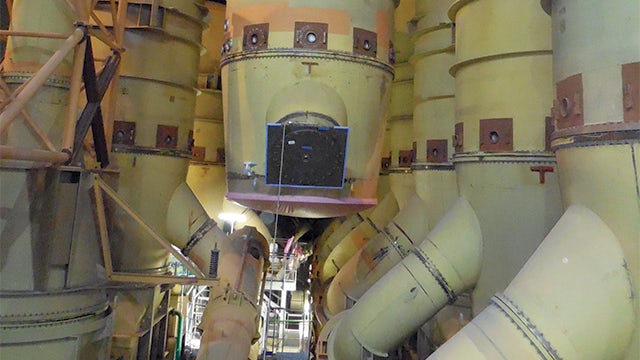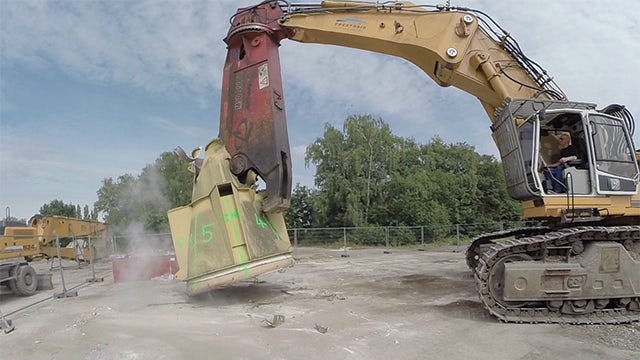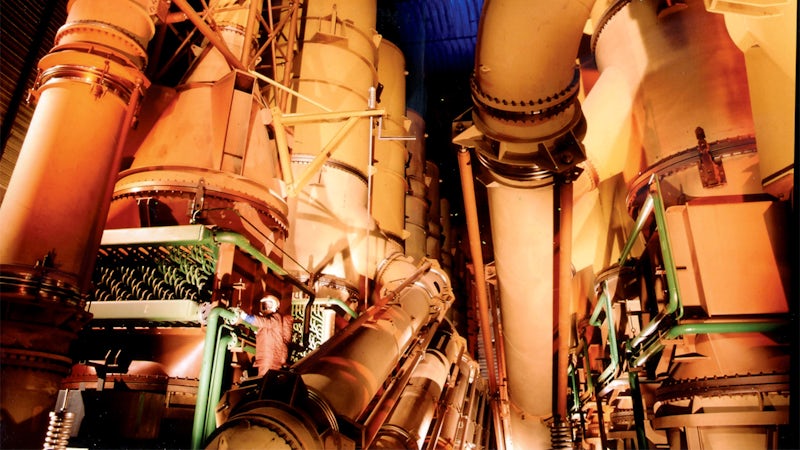INOPROD helps nuclear leader prepare site for new projects with Tecnomatix
AREVA and INOPROD use Plant Simulation to optimize workflows, control costs
AREVA
AREVA is a world leader in nuclear power, and is heavily involved in the nuclear fuel cycle, reactor design and related construction and operating services.
https://www.orano.group/en- Headquarters:
- Tricastin Site, France
- Products:
- General, Tecnomatix
- Industry Sector:
- Energy & utilities
Given the amounts of money invested (tens of millions of euros) and the repetitiveness of the operations, sizing the flows right from the onset is important. This solution helps us realize a controlled budget.
AREVA Dismantling & Services
Preparing nuclear sites for new projects
An international leader in nuclear and renewable energy, AREVA is the only company in the world with a presence in each industrial activity linked to nuclear energy. These include mining, chemistry, enrichment, fuel assembly, reprocessing, engineering, nuclear propulsion and reactors, treatment, recycling, stabilization and dismantling.
EURODIF Production, a subsidiary of AREVA, operates the Georges Besse plant located on the AREVA Tricastin nuclear site in France’s Drôme department. For more than 30 years, the plant has supplied enriched uranium to the nuclear reactors of more than 100 nuclear power plants in France and around the world. It has produced one quarter of the world’s requirements for uranium using the gaseous diffusion enrichment process, a highly innovative technology at the time of the site’s construction. The plant ceased commercial production in June 2012.
To renew its industrial facilities, AREVA opted to replace the gaseous diffusion technology used by EURODIF with the gas centrifugation enrichment process, and for that purpose built a new plant named Georges Besse II. The new technology offers significant advantages in terms of competitiveness, energy savings and reduced environmental footprint. The first modules were deployed for production in 2011. The plant will reach full capacity in 2016.
As part of EURODIF’s permanent shutdown of the old plant, rinsing operations commenced in June, 2013 to recover the residual uranium present in the facilities, thereby facilitating future dismantling operations. The first maceration step was completed in October, 2015, allowing for more than 300 metric tons of uranium to be regenerated. The second step for venting the equipment will be completed in 2016.
Following the rinsing operations, the next step is now emerging for EURODIF: the preparation of operations for dismantling and decommissioning installations. A dismantling application was submitted to the French Nuclear Safety Authority at the end of March, 2015, and is currently being examined. The project for the dismantling of the plant and its support installations (uranium annex, mechanical maintenance facility, cooling towers, and others) is currently in the design stage.

A large and complex dismantling project
“To effectively grasp the project’s technical and organizational issues, you have to keep in mind the huge scale of these facilities,” says Hervé-Claude Turbatte, EURODIF dismantling project leader with AREVA Dismantling & Services (D&S). “They comprise 1,400 gaseous diffusion stages, including diffusers, heat exchangers, and compressors, the largest of which weighs 140 tons, with an enrichment cascade that contains 28,000 tons of diffusion barriers. Covering a surface area of some 190,000 square meters, the buildings house 160,000 tons of metallic equipment in the processing circuits, or the equivalent of three Arcs de Triomphe.”
The dismantling operation will require five phases: disassembly of large equipment, deconstruction of the diffusers, grinding of the barriers, cutting of metal parts, and conditioning of waste for storage. Given the size and complexity of the facilities to decontaminate and dismantle, the project involves treating – for safety and security – substantial volumes of waste in restrictive conditions. In total, there are more than 200,000 metric tons of lowlevel waste, part of which could be sent to a facility for re-use by fusion, and to an ANDRA (French National Radioactive Waste Management Agency) center for storage. Conventional waste that is not contaminated (electrical control cabinets, cables, and other items) will be recycled.

Optimizing workflows
Studies aimed at optimally consolidating and sizing the dismantling workflows, along with the facilities created for conditioning the waste, began in 2013. The project must effectively maintain the schedules and control all costs, from the construction of resources required for the dismantling to the project’s completion, including the dismantling of the facilities and the clean-up of the civil engineering.
To conduct these studies, the project team selected the Plant Simulation solution in the Tecnomatix® portfolio from product lifecycle management (PLM) specialist Siemens Digital Industries Software, and sought the support of INOPROD, a Siemens Digital Industries Software partner specialized in modeling and simulating production flows.
“Used for simulating discrete events, Plant Simulation is a tool that can create digital models of logistical systems and treatment processes to explore their characteristics and optimize their performance,” says José Valente, project leader for simulations and flows with INOPROD. “The digital models help to assess a number of scenarios right from the design phase, well before the installation of actual production systems.”
The team decided to begin its modeling studies with the facilities that needed to be built for the future processing of the waste. An initial macroscopic model was created using Tecnomatix, then subsequently enhanced as the study progressed. Now comprising three levels, this model serves to evaluate – fairly precisely – a number of scenarios, and to produce indicators in terms of capacity and time, including quantities processed, processing times, and utilization rates.
The models are dynamic, and integrate decision-making concepts, such as the choice of path and productivity losses due to maintenance, failures, and other events. Using powerful analysis tools in Plant Simulation, such as statistics, graphs and analysis of bottlenecks, the team can readily evaluate alternative scenarios. The results provide the information needed to quickly make sound, reliable decisions right from the initial phases.
“From the project’s kick-off, we identified the importance of logistics and controlled flows,” explains Turbatte. “The software solution is rather like having a ‘justice of the peace’ for our capacity to treat the flows. Given the amounts of money invested (tens of millions of euros) and the repetitiveness of the operations, sizing the flows right from the onset is important. This solution thus helps us realize a controlled budget.”
Firstly, using Plant Simulation helped the team to check the right sizing of the proposed facilities in order to effectively demonstrate controlled costs. Additional studies were subsequently conducted to respond to needs in terms of optimizing costs, and adjusting the resources and production rates. The studies helped to answer many questions, including whether to add another press/shear; what level of reliability could be expected of the conveyor technology between the processing facilities; and whether the planning could be reduced, and if so, in return for which adjustments and at what cost. Using Plant Simulation helped the team confirm the feasibility of a reduction in lead times of between 20 and 30 percent in relation to the schedule defined for the nominal dismantling phase.
Nuclear safety is an ongoing, prevalent concern throughout the duration of the project, and ANDRA imposes stringent quality standards concerning waste management. The waste must be controlled and certified before going into storage. This requires the implementation of quality control together with traceability of the operations, including records of when a specific material was stocked, when it passed through a given location, and when it was stored in a given place.
The dismantling of a nuclear installation is a very long-term undertaking that involves a preparatory audit phase: assessment of the financial and technical resources required for the dismantling, determination and optimization of waste elimination routes according to a strict regulatory framework, definition of interventions and master plans, compliance with regulatory processes and obtaining authorizations, and so on. Next comes the implementation phase: construction of the facilities, oversight of the dismantling, operation of waste processing and conditioning installations, and finally, cleanup of the building structures.
Turbatte sums up the advantages to be gained from using Plant Simulation: “During the preliminary design phase, we perform simulations to determine the best cost/lead time/risk scenario. Thereafter, once the actual design has been determined, workflow models will be used to optimize the organization of work by factoring in flow variations resulting from dismantling operations and the load factor of the waste processing units. In particular, these models provide a response to current concerns in relation to the most suitable pace of work for the teams. Lastly, during the operation phase, the tool can help with decisions to reconfigure, when necessary, the organization of the work, and the scheduling of the projects in line with any unknown factors or planning requirements. Our guiding principle is to ensure the safety and security of operations while optimizing costs.”
Rethinking leads to quantum leap
Design according to measurements and dependencies, as it was known in the 2D world, peaked with the application of parametric modeling. When Siemens Digital Industries Software offered synchronous technology, a group of tools for directly influencing geometry elements, Supfina questioned the rule-based approach: “The building of parametric models takes place in a highly personalized manner,” says Müller. “As a result, making changes and re-using models becomes more difficult.”
Using synchronous technology enables Supfina to respond more rapidly to new requirements, thus saving time and money. Assemblies and components of suppliers can be scanned in, quickly edited and easily re-used. Also, the sample work pieces of customers can be more easily adapted afterwards.
In spite of all these advantages, changing over represented a big leap for the employees: “In particular, designers with many years of experience had to go through a fundamental rethinking process and had trouble parting with the measurements,” says Müller. “On the other hand, our American coworkers managed quite well with the new technology; they didn’t know anything different.” After three days of training by the ISAP and six months of transition time, a new era of 3D design began at Supfina.
“ISAP has proven itself to be a reliable partner over many years and succeeded in helping us over this hurdle,” says Müller, who annually evaluates the latest functions of Solid Edge as a beta tester.
Achieving positive results
Today only 20 percent of models are parametrically defined. In the case of revisions, components are transferred to synchronous technology. The results speak for themselves. For example, the company documented how the adjustment of a chuck jaw with conventional methods leads to termination after nine minutes; the consequence would be reconstruction. With synchronous technology the change was made in 40 seconds.
“Fast reaction times are imperative in today’s market,” notes Müller. “Without Solid Edge, we could not meet the increasingly shorter project time frames requested.”
The efficient design process leads to savings in other areas; from purchasing to warehousing to capital commitment in the workshop: “With the help of Solid Edge, we were able to measurably speed up the project phases, due to virtual machine models,” says Müller. In the process, market demands can be implemented more cost-effectively without sacrificing quality. It is precisely this that is supposed to make a new design of the machines visible to the eye. For example, designed with Solid Edge, Supfina’s Race machine won the Red Dot Design Award in 2012 and its CenFlex machine was awarded both the Red Dot Design Award and the iF Product Design Award in 2013.
Our guiding principle is to ensure the safety and security of operations while optimizing costs.
AREVA Dismantling & Services
